Engine Cooling System | Car engine Cooling System
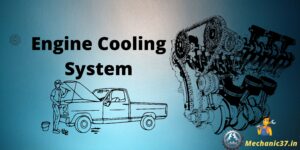
Engine Cooling System When the engine runs, a lot of heat is produced in it, due to which the temperature of the engine becomes very high, due to which there is a possibility of engine damage like engine seaz, engine starting problem, lack of combustion proper , Fuel Not Properly Buran All these are caused by overheating of the engine. When the engine is hot, the thermal efficiency of the engine decreases. Cooling system in all automobiles.
All the automobiles in today’s time have internal combustion in order to run their engine to update the cooling system. The heat produced during combustion is produced inside the engine cylinder itself. When heat is generated inside the cylinder, the temperature of the engine cylinder also increases. Convert all the heat generated inside the engine and the engine cylinder into useful work. Some of the heat is useful and some of the heat is in the waste form through the exhaust exhaust. But heat does the job of increasing the temperature of the engine. The thermal efficiency of the engine decreases as heat is produced in the engine. is the temperature of excess heat. It is important to exit the engine or automobile. were Engine exhaust is 40% heat. In the remaining heat, 30% of the heat rises in the engine and it is also waste heat. This heat is of no use. To maintain the engine temperature we need proper cooling system which while maintaining the engine temperature and reduce the temperature by large. Some methods for harnessing excess heat from engine cylinders are the cooling systems of automobiles, especially in simple language. There are Four types of Cooling System of Automobile. Which removes the Excess Heat from the Engine Cylinder. And reduce the temperature to certain limits. Due to which the performance of the engine increases and also the efficiency.
- Air Cooling System
- Water or Liquid Cooling System
- Liquid Cooling
Air Cooling System

This method of cooling the heat is dissipated directly to the air after being conducted through the cylinder walls fins and flanges on the outer surface of the cylinder and heads serve to increase the area exposed to the cooling air and so rate the rate of cooling. for effective air cooling the surface area of the metal which comes in contact with air is increased by providing fins over the cylinder barrels more the surface area in a contact with air, more the heat is dissipated. higher the rate of air flow, higher the heat is dissipated.
Advantages of Air-Cooled engines
- Lighter in weight due to the absence of radiator, cooling jakets and coolant
- Anti freeze not required
- No leak to guard against
Disadvantages For Cooling
- Less efficient cooling because the co-efficient of heat transfer for air is less than that for water
- Not easy to maintain even cooling all around the cylinder distortion of the cylinder may take place.
- More noisy operation
- Limited use in moter cycles and scooters where the cylinders are exposed to air stream
Water or Liquid Cooling System
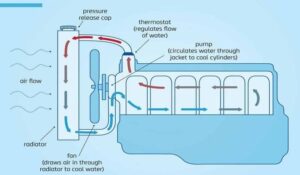
In This Method of cooling water is circulated through water jackets around each of the combustion Chamber, cylinder, valve seat and valve stem the circulating water when passes through the engine jackets in the block and cylinder heat takes heat of the combustion when it passes through radiator it is cooled by air drawn through the radiator by a fan and by air flow developed by the forward motion of the vehicle. after passing through the radiator the water again goes in the engine jackets. Components of the water cooling Methord
- Radiator
- Thermostat
- Pump
- Fan
- Water Jackets
- Coolant
Radiator
The radiator is a Heat Exchanger with two sets of passages. one set is for coolant and the other for outside air. The heat exchanger hat removes heat from coolant passing through it receives hot coolant from the engine and return the coolant to the engine at a lower temperature Radiator are usually made of copper and brass because of their high heat conductivity the various sections of the radiator are almost completely joined to gather by soldering.
Thermostat
A thermostat Valve is used in the water cooling system to regulate the circulation of water in system to maintain the normal working temperature of the engine parts during the different operation works in the cooling system. When the engine is cold the thermostat classes to prevent coolant circulation to the radiator the engine worm up the thermostat opens to allow coolant flow through the radiator.
Pump
A pump is used in the water cooling system to increase the velocity of the circulating water impeller type pump is mounted at the front end of the cylinder block between the block and the radiator the pump consist of a housing with inlet and outlet and an impeller. the impeller is a flat plate mounted on the pump shaft with a series of flat or curved blades or vanes when the impeller rotates the water between the blades is thrown outwards by centrifugal force, and is forced through the pump outlet and into the bottom of the radiator and the water from the radiator is drawn into the pump to replace the water forced though the outlet.the pump is driven by a belt to the drive pulley mounted on the front end of the engine crankshaft.
FAN
A fan is mounted behind the radiator on the water pump shaft it is driven by the same belt that driven the pump and the generator. the purpose of the fan is to drow air through the radiator. the fan requires a little power and usually runs at a speed greater than that of the crankshaft
Water Jackets
water jackets are cast into the cylinder bloc and beads jackets are simple the passanges through which water circulates around the cylinders valve ports and seats combustion chambers and any other hot parts that require cooling the heat of combustion is conducted through the metal walls to the water in the jackets which removes the excess heat as it circulates through the water jackets
Coolant
A coolant (also called an antifreeze) is a special fluid that runs through your engine to keep it within its correct operating temperature range. It is made from either ethylene glycol or propylene, water, some protection additives and is usually green, blue or even pink in colour Antifreeze is ethylene glycol is mixture of half water and half ethylene glycol
Liquid Cooling System
In this methods of cooling instead of water other liquids having higher boiler point are used for cooling glycerine and ethylene glycol are examples of such liquids due to their higher boiling point these liquids have increased capacity to carry heat, and hence the weight of coolant and radiator is decreased.
FAQ
-
What is the cooling system of the engine?
- The cooling system of an engine is designed to regulate and maintain the temperature of the engine by dissipating excess heat generated during combustion and friction.
-
What are the 2 types of cooling system?
- The two main types of engine cooling systems are liquid cooling and air cooling.
-
How does a cooling engine work?
- In a liquid cooling system, a coolant (usually a mixture of water and antifreeze) circulates through the engine, absorbing heat, and then passes through a radiator where the heat is dissipated. In air cooling, fins on the engine and a fan help dissipate heat into the surrounding air.
-
Where is the engine cooling system?
- The engine cooling system is integrated into the engine compartment and may include components such as a radiator, water pump, thermostat, and cooling fan.
-
Which is best in engine cooling system?
- The choice between liquid cooling and air cooling depends on factors like engine design and application. Liquid cooling is more common in modern vehicles due to its efficiency in heat dissipation.
-
Where is the cooling temperature?
- The cooling temperature varies, but for many engines, it is maintained around 195 to 220 degrees Fahrenheit (90 to 105 degrees Celsius).
-
What are the 4 functions of the engine cooling system?
- The four main functions are temperature regulation, prevention of overheating, efficient combustion, and protection against extreme cold temperatures.
-
What is the role of coolant?
- Coolant circulates through the engine, absorbing heat and carrying it to the radiator where it releases the heat. It also prevents freezing in cold temperatures and protects against corrosion.
-
Where is cooling used?
- Cooling is used in various applications, including automobile engines, industrial machinery, electronic devices, and power plants, to prevent overheating and ensure efficient operation.
-
What is cooling system service?
- Cooling system service involves maintenance tasks like checking coolant levels, inspecting hoses and belts, flushing the system, and ensuring all components function correctly to prevent engine overheating.
-
What are the three types of cooling system?
- The three main types are liquid cooling, air cooling, and hybrid systems that combine elements of both liquid and air cooling.
-
What is coolant in the cooling system?
- Coolant is a mixture of water and antifreeze that circulates through the engine to absorb and dissipate heat, as well as prevent freezing and corrosion.
-
What color is coolant?
- Coolants come in various colors, with common ones being green, orange, pink, or blue. The color is not an indicator of effectiveness; it depends on the type and brand of coolant used.

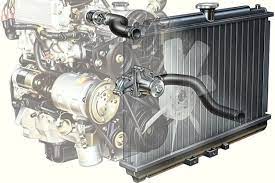
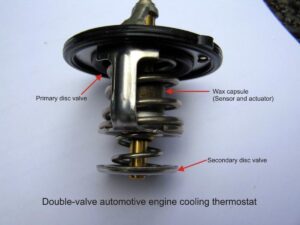
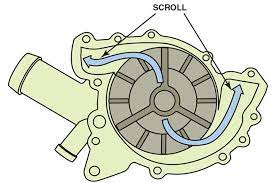
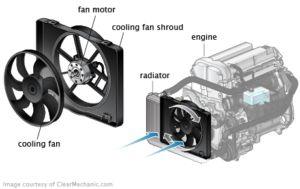

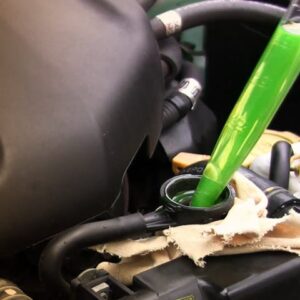



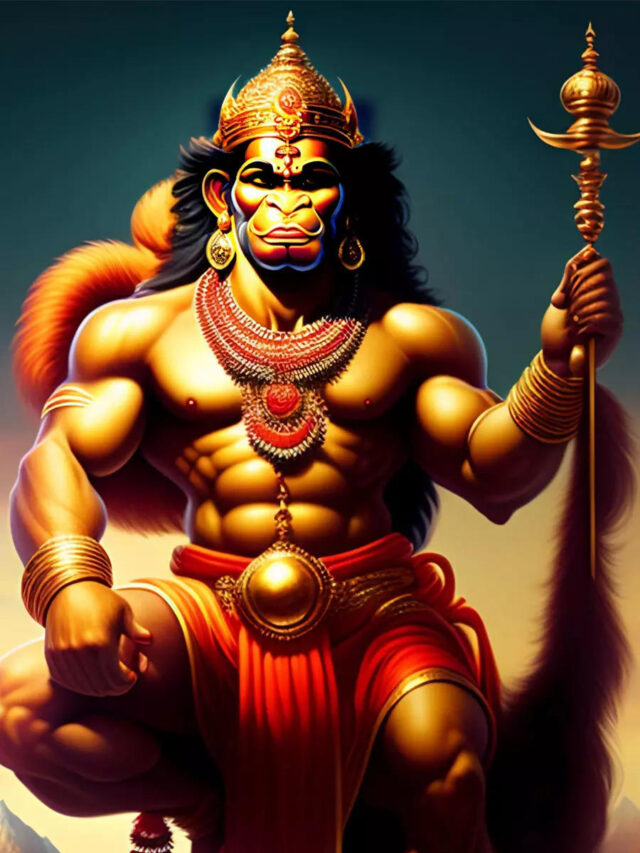

[…] Engine Cooling Water Jacket […]
[…] Engine Cooling System […]
[…] Engine Cooling System […]
[…] Engine Cooling Water Jacket […]